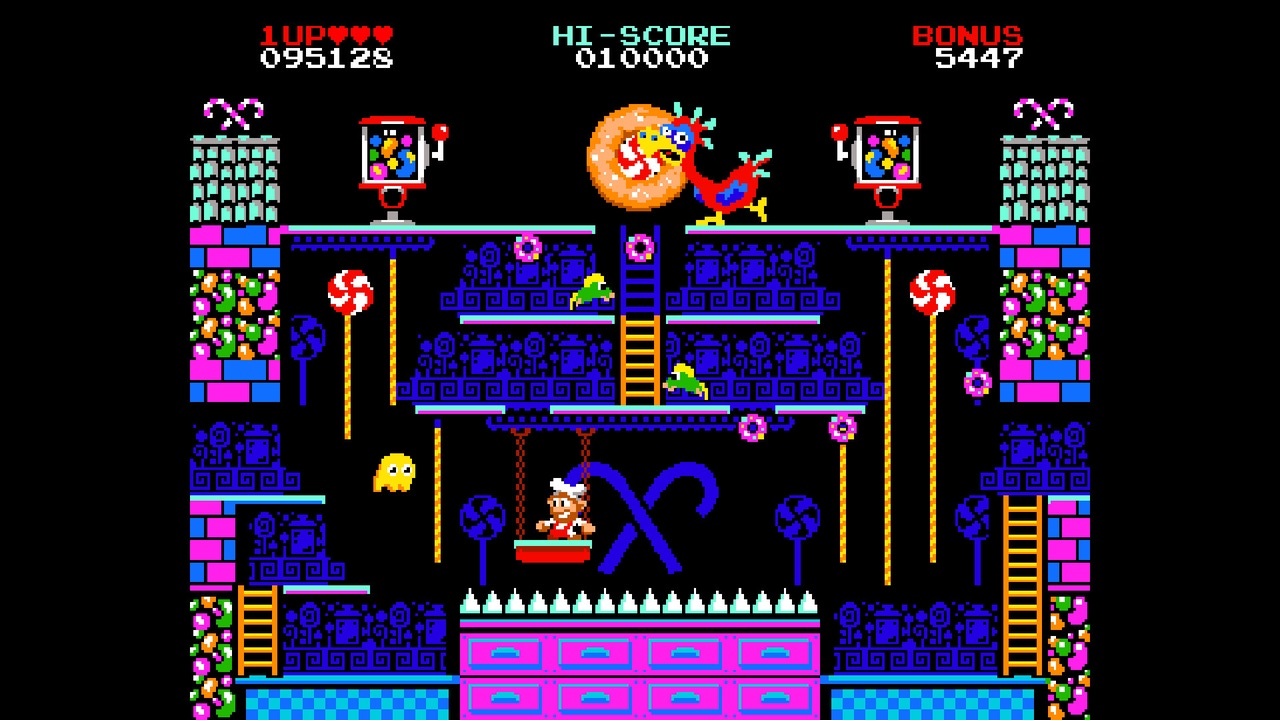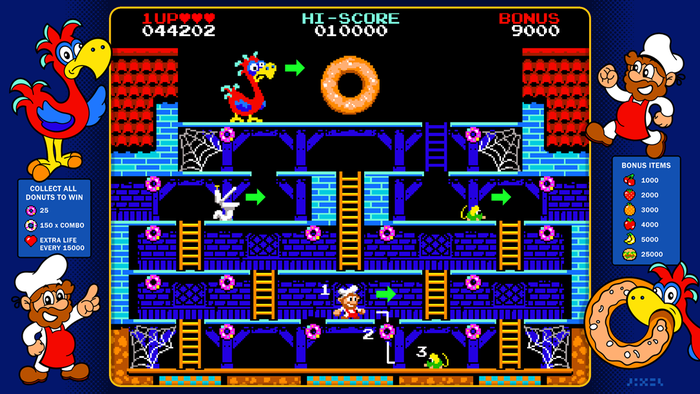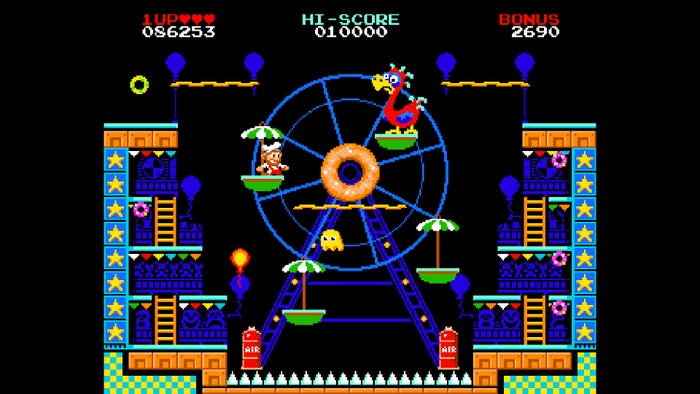Trending
Opinion: How will Project 2025 impact game developers?
The Heritage Foundation's manifesto for the possible next administration could do great harm to many, including large portions of the game development community.
How creator Sebastian Kostka is making sure certain arcade conventions don't go the way of the dodo.

Donut Dodo (available on Steam and Nintendo Switch, and with an extended version for exA-Arcadia) might be called by some a throwback. It’s got (gasp!) pixel art graphics. Each level is (shock!) a single screen. It’s (yikes!) unapologetically two-dimensional and takes its design cues from the classic era of arcades. But it’s got charming art, challenging play, and an interesting design that seems to have struck a chord among many players, and now it even has a bona fide release for arcades. We’re grateful that its creator, Sebastian Kostka, has taken time from his work to answer our questions about Donut Dodo.
Game Developer: Who are you, and what is Donut Dodo?
Kostka: Hi, I am Sebastian Kostka, founder and owner of the one-person studio, pixel games SARL-S. My main focus is to create classic arcade games that integrate modern gameplay mechanics for current-gen systems.
A recent example would be Donut Dodo, an arcade game that looks and sounds like the classics it was inspired by yet does not really play like its predecessors.
Speaking of predecessors, I was fortunate enough to witness the birth of the videogame industry and have been fascinated by its evolution ever since. The moments that had the greatest impact on me are the ones that help me shape the games I create today.
Video and computer games today, even indie ones, tend to have different design attributes now than in the classic days of arcades. It really was not that long of a period; after all, there were only five years between Space Invaders and U.S. Game Crash. And yet, many games released for arcades back then have had a hold on the popular imagination that even newer games can’t match. I feel like there’s something about Donkey Kong, for example, that immediately suggests “video game” in a way that Elden Ring or Minecraft do not. What appealed to you about making a classic arcade-type game?
I passionately follow the evolution of gaming from a technical and technological point of view but lost interest in AAA games many years ago.
What I seek in games today is very similar to what I found in the arcade classics of yesteryear: simple, yet creative; short yet impactful experiences. As an indie developer, I am fortunate enough to be able to make the kind of goofy games I myself love to play, without much consideration for financial viability or market share.
While my games primarily target the Atari 2600 generation, which I am also part of and have developed an intimate understanding for over the years, I was surprised that Donut Dodo has been adopted by players of all ages, including those who are not familiar with the classics or even the arcade genre.
It just goes to show how timeless these games can be when adapted to modern standards and expectations.
What would you say are the essential elements of a classic-styled arcade game?
“Easy to learn but hard to master” has been overused over the years. However, it’s still, without a doubt, the secret sauce for creating an engaging experience for the player.
It is important to consider those two principles for every design decision in arcade-styled games, from clear rules and objectives to enemy color coding and pacing. To illustrate this, I'll provide some insight into how the first stage of Donut Dodo was designed to create one of the shortest in-game tutorials ever.
When the game starts, all enemies above the player are facing right, suggesting that imminent danger will come from the left. The player character is also facing right, signaling to the player to run in that direction as soon as the action starts. As they will find out, it’s a deadly trap.
During the first second of gameplay, the player will:
1) fall off a ledge (mechanics)
2) collect a donut on the way down and earn points (objectives)
3) collide with a moving hazard below and die instantly (rules)
Lesson learned. That’s all the player needs to understand how to play and eventually clear the game.

First chain of events. Image via pixel games SARL-S.
There are roughly three types of extra-life award schemes in classic-era arcade games: the kind that gives one (or, on harder settings, even no) extra lives, the kind that gives out one life at a relatively easy-to-reach point and then additional ones after much larger score awards, and the kind that give out lives regularly. I think this is a useful indicator of how difficult the developer thinks the game is. Donut Dodo awards extra lives frequently and at relatively modest score points, suggesting the game is quite difficult. What are your thoughts?
I’m actually really satisfied with how it works. Initially, most players seem to find the game quite punishing, and welcome the seemingly accessible extra lives. But without going for the glowing donut combos, the score only increases slowly, leading to few extra lives being earned.
Low risk, low reward.
Once players decide to go all in, competing for high scores on the leaderboards and collecting a maximum number of combos and extra lives, the high-risk gameplay leads to frequent deaths and balances things out.
Finally, since points are awarded for each remaining life upon completion of the game, it becomes an integral part of the strategy, depending on play style. Even players who failed to collect all the combos can still grab a top spot on the leaderboards due to earning and preserving enough extra lives.
Donut Dodo seems like it uses an “obstacle course” philosophy of level design. Most of the hazards follow set movement patterns and don’t care where Chef Billy moves. The Dodo causes the player to lose a life if they touch it, but doesn’t seem to aim its fireballs at Billy. The main hazard that follows Billy is “Stinky,” the angry roving toilet, and it’s not even in every level. Compare this to Donkey Kong’s barrels, which are affected by Jumpman’s position even if they appear not to be. I think it’s interesting that the game was designed like this. How did you balance it, and why include the toilet when it’s already difficult with obstacles that don’t chase Billy?
Technically, the Dodo constantly tracks all of Billy’s actions and does adapt to them. The fact that the bird’s reactions are delayed and sometimes even pointless is part of its goofy character design. The bird is simply not very smart and takes a while to process what’s going on.
Stinky, however, is the exact opposite. I found the idea of having this hyper-focused, rogue toilet that can climb ladders and jump gaps to be quite funny. I added this character to the first and last stages as I wanted both of them to have a sense of urgency.
For some reason, in the early ‘80s, so many European home computer games contained toilets. This fascinated me as a kid. For me, Donut Dodo, which is essentially a love letter to all my fondest gaming memories, presented the perfect opportunity to include Stinky.
The toilet often frustrates new players, as it cannot be jumped over, but its movement patterns are predictable, and once these are understood, Stinky can easily be outmaneuvered.
Donut Dodo contains a number of references to Nintendo games, especially early ones: the graphic design of the Oil barrels (and similarly-designed Air tanks), the sine-wave patterns of Winky being similar to the fireballs in Mario Bros., the ropes being climbable DK Jr. style (climbing using one rope or with hands across two), and the Dodo serving a kind of silly, wall-eyed Donkey Kong. Would you consider Nintendo’s arcade titles to be your game’s lodestar?
Absolutely, the references to Nintendo titles are immediately recognizable, and perhaps a sign of the fondness I have for them. That said, during the creative phase, I never intended for the Dodo character to be a Donkey Kong equivalent. However, in hindsight, the inspiration seems obvious.
Other than that, Donut Dodo also takes inspiration from many early Namco games, many of which I have a soft spot for and still enjoy today.
Interestingly, I did not play any of these titles in the months leading up to creating Donut Dodo, as I did not want to fall in the trap of trying to emulate their gameplay mechanics instead of creating a fresh experience. Though I did study many videos, mainly helping to recreate authentic representations of the scoreboards and attract screens for the project.

Image via Sebastian Kostka.
A nice design feature of Donut Dodo is that it’s careful to make sure all threats are adequately telegraphed. When enemies come out of doorways in the Lair level, the game puts an exclamation point over them; when Winky makes a pass across the screen, a flashing warning icon heralds their appearance. These are play aids that would have been appreciated in some classic arcade games. Were you motivated by care for the player’s experience, a personal experience with classic games, or what?
This is one of the things where we now have access to decades of experience and know-how making games, a luxury the early classics did not have.
In my opinion, these modern forms of communication within a game are essential, signaling to the player what is happening, when, and where. I consider these design elements to be mandatory, especially in high-action situations that are otherwise hard to keep track of.
This also transfers all responsibility from the game to the player who now, having been warned about an imminent threat, can make an informed gameplay decision, either good or bad, then learn from it.
Over time, reacting to these audiovisual cues practically becomes subconscious and instinctive, at which point the player is said to be ‘in the zone,’ a state typically referred to in arcade games, usually shmups.
One interesting design touch is the ability to collect the donuts needed to finish a level in any order. When you pick up the first, another donut is highlighted, and as you collect them, if you get them in the indicated order, you get more points. This gives a player a way of deciding what difficulty they want to play at: they can just aim to complete the game, collect all the donuts easily, or go out of their way to get them in a specific order to obtain a greater reward. It’s an element of design unavailable to many recent games that deemphasize score. Do you worry about players, trained on those games, rushing through, getting the donuts willy-nilly, who might consider the game “conquered?”
Initially, most players find it challenging enough just to complete the game without worrying about the flashing donuts or understanding their significance. It's only after they reach the end screen that they become familiar with the enemy patterns and intricacies of each stage.
However, the leaderboards have been designed in such a way that merely completing the game will result in a score ranking at the lower end of the table. This signals to the player that there must be other ways to accumulate points and that there's more to the scoring system than meets the eye.
Despite the game being completable in just a few minutes, the overall average playtime of several hours suggests that most players are eager to pursue new high scores after initially clearing the game.
I was surprised to see an actual arcade version of Donut Dodo, called Donut Dodo Do!, is available, for the exA-Arcadia platform. How did the opportunity arise? Given that Donut Dodo already emulates an arcade experience, how did you change the game to support a genuine pay-for-play format?
The timing was interesting. I was just about to start on a new game project when the guys at exA-Arcadia somehow found out about Donut Dodo and got in touch to discuss the prospect of publishing the game on their system.
After giving it some thought, I decided to shelve the prototypes I was working on and commit to making an arcade version of the game.
While the gameplay loop has basically remained unchanged compared to the home release, I found the technical aspect of porting Donut Dodo to an arcade system to be a major undertaking, which actually took me longer to develop than the original game!
There are just so many moving parts and things to keep track of in a multiplayer arcade game.
Speaking of multiplayer, Donut Dodo Do! incorporates an exclusive 2-player mode, introducing chef Bella Burns, Billy’s wife.
This decision has been surprisingly controversial, while many players had hoped to see their home release potentially accommodate a 2-player mode at some point.
Besides the Bella character, we added an additional exclusive level, more music, different game modes, daily leaderboards, and other new features to round things up.
While from a business perspective, it remains to be seen if there is still demand for this style of game in the professional operator market, I’m really happy with how it turned out, and wish that someday, it might stand in a dimly lit arcade between the classics that inspired it.
You May Also Like